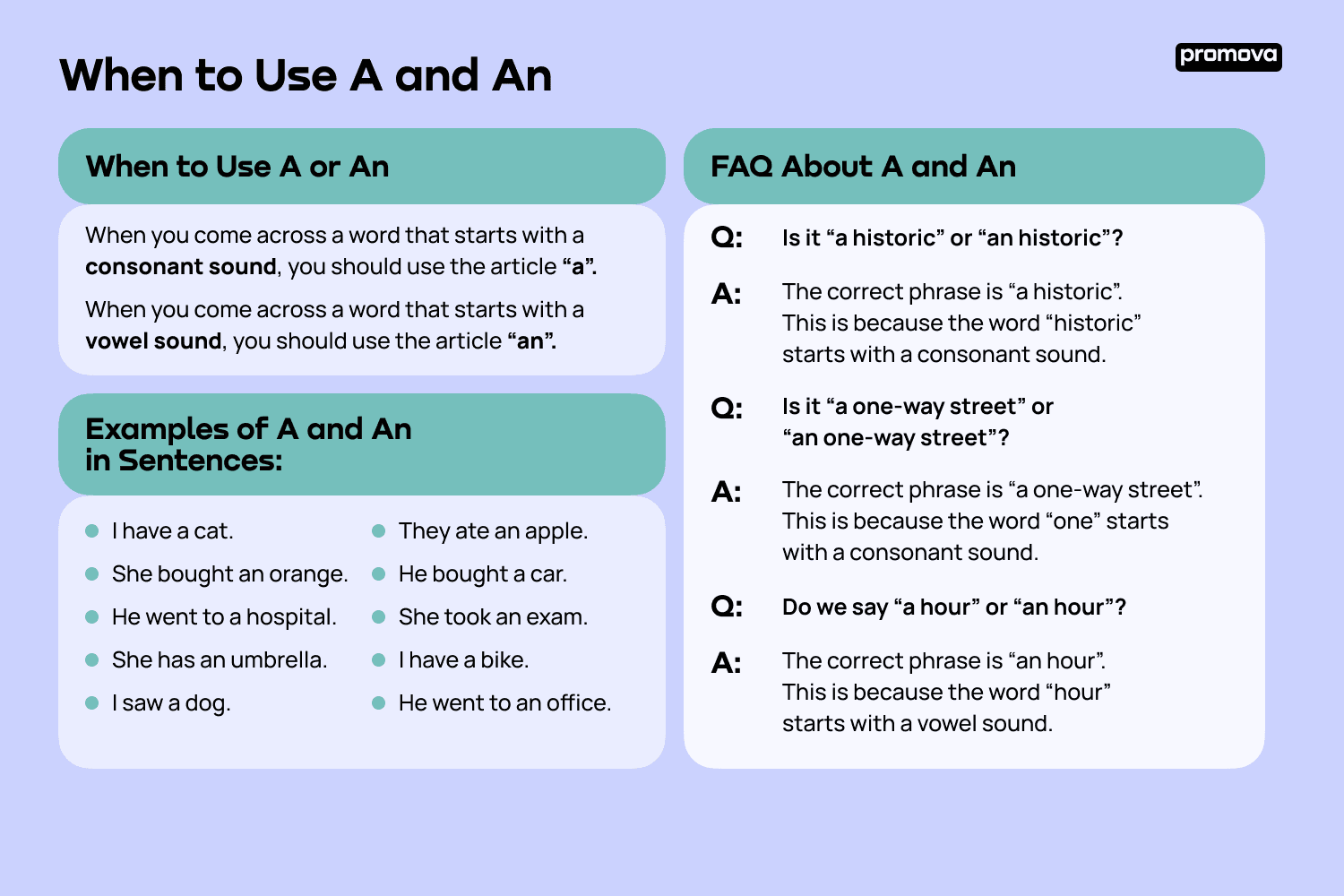When to Use “A” and “An” In English
Contents
Choosing the correct article in English can sometimes be tricky, especially when deciding between "a" and "an." Even advanced learners may make mistakes occasionally.
These two articles, "a" and "an," can cause confusion. In this guide, you’ll learn how to use them, understand their differences, exceptions, and see clear examples in sentences to make everything easier.
The Differences Between "A" and "An" in English
Let’s start with the basics: What do "a" and "an" mean in English?
These two words are both used to refer to a single one of something. So you might wonder, “So how do I know when to use each one?” Don’t worry, there’s a simple rule to help you distinguish them:
- "A" is used before words that start with a consonant sound. Example: a dog, a house, a university.
- "An" is used before words that start with a vowel sound. Example: an apple, an hour, an idea.
Understanding this difference is key to speaking and writing correctly in English. While this rule is clear, it’s important to remember that it’s about the initial sound of the word, not just the first letter.
Let’s explore more details and examples to clarify the use of "a" and "an."
When to Use "A"
The article "a" is used with words that start with a consonant sound, meaning any sound that isn’t a vowel. Consonant sounds in English include: b, c, d, f, g, h, j, k, l, m, n, p, q, r, s, t, v, w, x, y, z.
Examples:
- I saw a dog in the park.
- She wants to buy a car.
- There is a book on the table.
When to Use "An"
The article "an" is used with words that start with a vowel sound, such as "a," "e," "i," "o," or "u." Examples of vowel sounds include: "ah," "eh," "ee," "oh," and "oo."
Examples:
- He ate an apple for breakfast.
- She has an idea for the project.
- We saw an eagle flying.
Remember, what matters is the sound of the word, not just the first letter. For instance, in words like “hour” where the "h" is silent, you still use “an.”
1
Exceptions to the "A" and "An" Rule
While the "a" and "an" rule is generally straightforward, there are some exceptions, particularly with the letter "u":
- If the word begins with a consonant sound, use “a”.
Example: “a university” (The initial sound is "yoo," which is consonant-like). - If the word begins with a vowel sound, use “an”.
Example: “an umbrella” (The initial sound is "uh," which is a vowel sound).
"A" and "An" with Plurals
When using "a" or "an" with plural nouns, the article is usually omitted altogether. This applies to both countable and uncountable nouns.
Examples:
- “I have computers.”
- “She bought oranges.”
The only exception is when talking about a group, in which case "a" is used to describe the collective. Examples with collective nouns:
- “I saw a group of students.”
- “She has a big family.”
- “He joined a soccer team.”
Use "a" to refer to the group as a whole but omit the article for individual plural nouns. This will help you use articles correctly in English.
Examples of "A" and "An" in Sentences
Here are some examples to reinforce the correct use of "a" and "an":
- I have a piano.
- She bought an apple.
- He went to a hospital.
- Tracy has an umbrella.
- Liz saw a dog.
- They ate an ice cream.
- He bought a new phone.
- Jack took an exam.
- I rented a bike.
- He went to an office.
Frequently Asked Questions About "A" and "An"
To help you better understand the rule for "a" and "an," here are the answers to some common questions about these articles:
- Q: Is it "a historic" or "an historic"?
The correct phrase is "a historic." This is because the word "historic" begins with a consonant sound.
- Q: Is it "a one-way street" or "an one-way street"?
The correct phrase is "a one-way street." This is because the word "one" starts with a consonant sound.
- Q: Is it "a hour" or "an hour"?
The correct phrase is "an hour." This is because the word "hour" begins with a vowel sound.

Summary
The rule for using "a" and "an" is very simple to learn once you understand what vowel and consonant sounds are in English.
Remember that we use "a" for words that begin with a consonant sound and "an" for words that begin with a vowel sound. When dealing with plural nouns, the article is omitted, unless you are talking about collective nouns.
With a bit of practice, you'll master the use of these articles and improve your English fluency. Keep practicing!



Comments